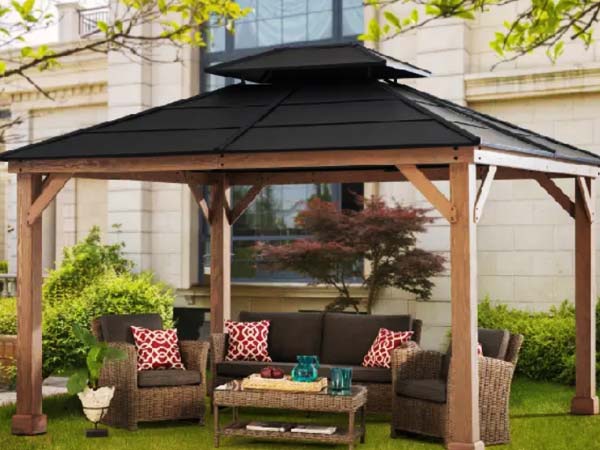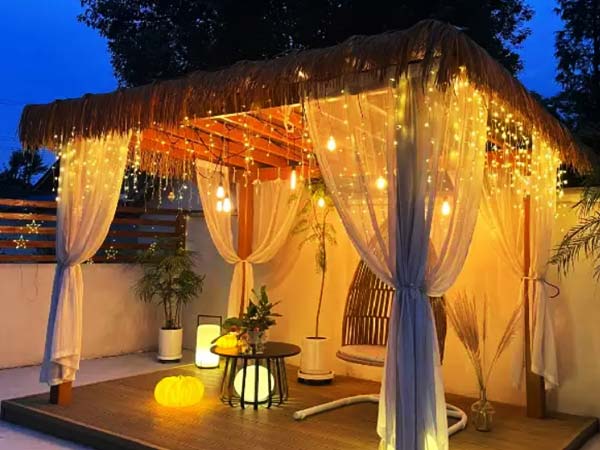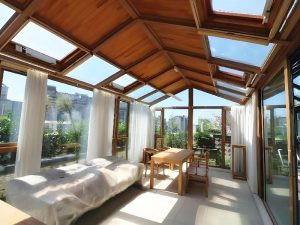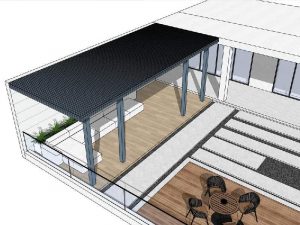A gazebo can provide shade and shelter and can enhance your outdoor experiences, whether for family gatherings, casual drinks, or simply enjoying alone time. However, strong winds can cause concern, especially regarding the safety and stability of your gazebo. Imagine hosting a backyard party under a stylish gazebo—everyone’s enjoying themselves until strong winds arrive. The curtains flap, the frame shakes, and safety suddenly becomes a concern.

This raises an important question: how should you handle a gazebo in high winds? Should it remain open, or is it better to close it completely? As a professional hardtop gazebo manufacturer, we’ve seen firsthand how wind impacts different gazebo designs. In this article, we’ll share expert insights on when to open or close your gazebo, how structure and materials affect wind resistance, and what practical steps you can take to prevent damage and ensure safety—even in harsh weather.
Don’t Miss: How Much Wind Can A Gazebo Withstand?
Gazebo Structures & Materials
Should you open or close your gazebo in windy conditions? The answer depends on your gazebo’s structure and performance in high winds. Gazebos are generally categorized into two types: open and closed.
1. Open Gazebos
Open gazebos have an open-sided design with only a roof, allowing air to flow freely and reducing wind pressure on the structure. In windy conditions, open gazebos let wind pass through, lowering the risk of uplift or collapse. However, keep in mind that even open gazebos are not immune—wind passing over the roof can create lift force due to pressure differences (similar to how airplane wings work). That’s why securing connectors and roof anchors remains critical in all scenarios.

2. Closed Gazebos
Closed gazebos have side curtains, walls, or windows, offering better shade, rain protection, and privacy. However, this design can trap wind inside during storms, creating internal air pressure that places a significant load on the canopy and frame—potentially leading to collapse or damage. Therefore, you should avoid partial opening during the wind since leaving only some curtains open creates unbalanced airflow: wind enters but can’t exit smoothly, forming a ballooning effect that lifts the roof and stresses the frame. In contrast, either keep all sides open to allow full airflow or close all sides and ensure the structure is tightly sealed and reinforced.

3. Material and Structure Impact
Beyond the open or closed design, a gazebo’s materials and structure impact its wind resistance. For instance, pop-up and soft-top gazebos are not ideal for windy conditions. Hard-top gazebos made of metal or wood are preferable, as solid materials like wood or steel withstand strong winds better than lightweight alternatives. Additionally, some gazebos feature a double-vented roof, which can help reduce wind pressure.
High winds can affect a gazebo in three main ways:
- Canopy: The canopy bears direct wind pressure, which can lift or tear lighter materials like canvas or polyester. Even with a slanted roof, extreme winds still pose a risk.
- Poles and Frame: Wind exerts lateral pressure on poles and frames, potentially causing them to bend, snap, or loosen where they connect to the ground.
- Overall Structure: Wind vibrations can destabilize the frame, loosen connectors, and possibly cause the gazebo to lean or collapse.
How to Prevent Your Gazebo from Blowing Away
Choosing the right gazebo and applying appropriate windproofing methods will depend on the strength of the wind you’re expecting. Different wind levels require tailored approaches to ensure your gazebo remains safe and secure.
1. Tips for Light to Moderate Winds (≤ Level 5)
In light or moderate winds (below level 5), the impact on a gazebo is minimal, and the canopy and frame should hold up well. You can relax and enjoy the gentle breeze with family or friends without much concern. If your gazebo has side curtains, secure them tightly to prevent them from swaying and destabilizing the structure. Gazebos with double-layered side curtains can be especially helpful—the outer layer can be opened to reduce wind pressure, while the inner layer maintains privacy.

If the wind increases, you can adjust the side curtains based on the wind direction. For example, if the wind is blowing from west to east, open the east and west sides while keeping the north and south sides closed. This setup lets wind flow through the gazebo smoothly, reducing lateral pressure and better protecting the canopy and frame.
2. Recommendations for Strong Winds and Storms (≥ Level 7)
While many quality gazebos are designed to withstand winds up to level 7, and premium models up to level 10, additional reinforcement is still advised in strong winds. Be sure to secure any items inside the gazebo or move them to a safe place to prevent them from being blown away and causing secondary hazards.

It’s safest not to use the gazebo during extreme weather. If your gazebo is easy to dismantle, take it down and store it until the storm passes. If dismantling isn’t an option, remove all items and clear the area to avoid potential hazards.
How to Reinforce Your Gazebo Against Strong Winds
If you own a gazebo, these practical steps can help enhance its stability and keep it secure in windy conditions.
- Remove the Canopy and Side Curtains: Removing the canopy and curtains reduces wind resistance and minimizes the risk of damage. If these parts are detachable, remove them to avoid potential harm. Illustration: Strong winds lifting gazebo side curtains
- Use Ground Stakes and Ropes: Secure the gazebo to the ground by staking each corner and using ropes. For extra stability, consider setting the gazebo on a concrete surface and anchoring it with expansion bolts.
- Add Weights: Placing sandbags, water containers, or iron weights on the frame’s legs can significantly reduce the risk of the gazebo tipping over in the wind.
- Reinforce Connections: Regularly inspect and tighten all screws, joints, and connectors to maintain stability. Check for rotted areas for wooden gazebos and replace weak parts to increase durability. Also, clear any tree branches or debris on the canopy, as these could blow off and cause accidents.
6 Preventive Measures for Gazebos in Windy Conditions
To ensure your gazebo withstands windy conditions, consider these proactive steps:
- Choose a Wind-Resistant Gazebo: When purchasing a gazebo, opt for a sturdy model with a durable design. Hard-top gazebos made of metal or solid wood offer the best wind resistance.
- Install and Secure Properly: Follow the installation instructions carefully or hire a professional for setup. Use ground stakes, anchor bolts, or sandbags to secure the gazebo firmly to the ground. Illustration: Gazebo poles secured with concrete on a balcony
- Regular Inspections and Maintenance Inspect the canopy, poles, connectors, and fasteners periodically. If you find any loose or worn parts, repair or replace them to maintain stability.
- Monitor Weather Forecasts: During windy seasons, stay updated on weather conditions. If strong winds or storms are forecasted, take precautions by removing the canopy, taking down side curtains, or even temporarily dismantling the gazebo.
- Avoid Using the Gazebo in Extreme Weather: It’s best to avoid using the gazebo during storms or high winds. If possible, dismantle or reinforce it to ensure safety.
- Safety Education: Ensure family members or employees understand safety measures for high-wind situations so everyone can take quick action.
Conclusion
A well-chosen, wind-resistant gazebo provides comfort and durability, even in challenging weather. By opting for a sturdy design, securing it properly, and performing routine maintenance, you can reduce wind damage risks and protect both your property and guests. Regular checks on fasteners and the structure, along with monitoring the weather, allow for timely actions like securing loose items or removing the canopy in extreme conditions. These simple steps give peace of mind and extend your gazebo’s lifespan.
For businesses or organizations interested in purchasing high-quality, wind-resistant gazebos in bulk, LIDA OUTDOOR offers a range of durable, weather-resistant models ideal for various environments. Contact us to find the perfect solution that meets your needs and withstands the elements.




